![[Metroactive Features]](http://metroactive.com/features/gifs/feat468.gif)
[ Features Index | Santa Cruz | Metroactive Home | Archives ]
Makeover in the Making: The plan is to convert a former tannery into an arts center and a cultural hub.
Grilling the Tannery
Movers and shakers behind the Tannery Arts Center project respond to your FAQs
By Mike Connor
Judging by the concerns voiced at the Tannery Arts Center Community Conversation last month, Santa Cruzans still have a lot to learn about the project. The plan is to convert the former tannery building and site into an arts center, where artists can live and work (allegedly at affordable rates), while creating a cultural hub to attract tourists to the tannery's riverfront location, off Highways 1 and 9.
At last count, the estimated cost of the Tannery Arts Center was $43 million, money that planners insist won't drain the city's general fund. And then there were those calls from citizens, demanding that an Environmental Impact Report be conducted, when, in fact, the final EIR was completed in April.
All of which has amplified our sense that the community remains vastly underinformed about this project. With the City Council preparing to vote to approve the site plan for the Tannery Arts Center at a June 14 hearing, we can well imagine what could happen if a Coast Hotel-sensitized public winds up feeling left out of the process.
With this in mind, we compiled a list of questions from tannery meetings, combined them with our own concerns and grilled Tannery Arts Center project director George Newell and Redevelopment Agency assistant director Joe Hall at length. Meanwhile, the Santa Cruz Institute of Contemporary Arts, in conjunction with the Tannery Arts Center, is sponsoring a "call to artists" to record their first impressions of the project, this coming Sunday, June 12, 1-5pm. Call 831.234.2272, or email [email protected], or [email protected], for details. And read on for answers to your most FAQs about the tannery conversion project.
METRO SANTA CRUZ: What is the vision of the Tannery Arts Center?
GEORGE NEWELL: To create an affordable home for the arts in Santa Cruz County dedicated to creating opportunities for individual arts organizations, residents and visitors to Santa Cruz County to create, explore, perform, exhibit, learn and enjoy the arts. The Tannery Arts Center project will convert the old Salz Tannery located on 8.3 acres of land near downtown. Overall, the project is three different projects in one: it's an affordable housing program, it's a historic preservation program and finally it's an economic development program.
Tell us about the live/work housing component.
GN: Approximately 100 units of affordable housing will be provided in new construction for artists and their families with low and very low incomes ($40,000/year to $16,000/year). [Numbers extrapolated from IRS federal low-income housing guidelines requiring applicants to make between 60 percent and 30 percent of the Area Median Income.] Units will range in size from 600-square-feet studio apartments to 1,200-square-feet three-bedroom apartments. Rent will range from approximately $385 to $900 per month.
How about the working studios?
GN: Five buildings of historical value will be renovated and preserved to provide large studio spaces with durable surfaces, high ceilings and abundant natural light for artists and groups of artists.
What about the Arts and Education Center?
GN: The Arts and Education Center will consist of new construction and renovated historical structures surrounding a central courtyard, providing space for offices for local arts organizations, two performances venues (music and theater), Santa Cruz Ballet studio, classroom and rehearsal space, galleries, shops and restaurants and open-air courtyards and access to the river.
How will the project be funded?
GN: It's a complex matrix of borrowing, grants and financing that will raise the money. It's not being financed on the back of the city's general fund and would not be a drain to the city's general fund. The city is really not obliged to pay for the construction of the tannery; their commitment so far has been to use affordable-housing funds to purchase the property, which they use in a number of affordable housing projects. That $6 million which comes from redevelopment funds has to be used for affordable housing projects, and they're using that money to purchase the land. As far as the construction of the project, it's the responsibility of the developers. We, the Tannery Arts Center, in partnership with Artspace, are the developers, and we have to raise the money to cover the costs of construction. [See Budget Notes for a detailed breakdown.]
Who will own the land?
JOE HALL: The Redevelopment Agency.
Who will operate/manage the facility?
JH: The Redevelopment Agency will lease the land to the housing developer, Artspace, for the affordable housing, and another nonprofit, the Tannery Arts Center, who will manage the studios.
How will the soil contaminants, which include arsenic, cadmium, hexavalent chromium, lead and petroleum hydrocarbons, be cleaned up? How much will it cost and who will pay for it?
JH: The department of the state that's responsible is called the Department of Toxic Substances Control, and they're now reviewing a draft cleanup plan for the site. At this point in time, we're not sure but it'll be somewhere under about $1 million. There will be a combination of things that will be done on the site. Some areas will be dug up, other areas will be covered and capped, and there are other areas where they'll use different types of treatment to pull the contaminants out. At this point, the $1 million will be the responsibility of the property owners--the Lezins.
What happens if more contaminants are found later?
JH: It's the responsibility of the former owners to clean that up. How that happens is a difficult legal question, but it's their responsibility to clean it up. What you really want to do is identify as much as possible now--the site's not a big site and it's been very thoroughly tested. [The tannery] has been through a thorough series of testing over a period of 20 years. The site's been extensively drilled, and there haven't been that many chemicals used on the site. This wasn't a dump site for a whole town; this was a specific industrial site.
What are the flood risks for the site?
JH: There are two areas on the site that are kind of divided in terms of what we call flood frequency. The southern part of the property is very low, and it can flood with 1 or 2 feet of water about every three to five years, and that's what's called the frequent flood area. The area with the older tannery buildings is quite a bit higher, about 3 to 4 feet. It's still subject to flooding, but at a much lower frequency.
There's been no recorded flooding of the actual old tannery buildings that we can find and they've been there about 125 years, but it's still technically defined as a flood plain, so at some point in a 100-year period, those older buildings will flood, in theory. In history, they've never flooded.
Will the new buildings be subject to flooding?
JH: The housing will spread into the frequent flooding area. What will happen is two things. In the housing part, we've been able to work with the FEMA rules and our hydrologist to where we can take the garage floor and elevate it about 2 feet, so that'll take the garage floor out of the flood area--it'll just be lifted up. Then the residential buildings will be another 10 feet above that, so the residences are above what's projected to be the 100-year flood level, but the cars are out of what's called frequent flooding, so they'll be protected on a three-to-five-year basis. If we get a higher level of flooding, then the cars will have to be evacuated. So that's what's being done to protect the housing.
In terms of the other buildings, the new buildings have to be flood-proofed, and that means that they have to be built with higher windows and things like that so the water won't penetrate it as easily, and it's a little complicated to do, but we built downtown and it was in a floodplain and we went through all those same rules with it, too.
In the event of a major flood, would residents' cars be swept down the river?
JH: What will have to happen in the building is that the manager will probably have to have a key to all the cars, so that if somebody isn't there, if the water does rise, there's enough warning to get the cars out. They'll just drive them out to a higher place. There has to be some kind of coordination, a little bit more than at a regular apartment building because somebody could go on vacation and leave it in the middle of the winter, and if you get the 30-year floods, the cars could get wet. But there won't be that fast-moving water in these areas because the bridge only has so wide of an opening, and it's kind of like a dam; the water that moves fast will be actually in the middle of the river. As you get away from the river, the water slows down and it just lifts up. The water off to the sides is more like ponding water.
Can this project move forward in a way that will allow Central Home Supply to continue to do business in that location?
JH: Central Home Supply lives on three pieces of land. What they own, what the state owns, and some property that they rent from the Lezins. They were in business for many years without the Lezins' property. I think the main issue that they have is with the proposal that the county has in their regional transportation plan for a park/ride lot there, but that has nothing to do with this project. This project was separate from it.
GN: Central Home Supply currently operates on an acre-and-a-half of land they rent from Caltrans. They only leased the tannery property since it closed about three or four years ago. We listened to their concerns about available space and we dropped the park-and-ride part from our project. With regard to the area leased from the tannery, we've agreed we would phase in the use of that area over the next four-five years, allowing them time to rearrange the way they use the property they own and the property they lease from Caltrans so it won't impinge upon the way they do business now. I think they've only been using it for the last four years, they ought to be able to figure out a way to arrange stuff on the property so that they can stay in business, and I believe that they can.
The other way that we're trying to accommodate them is that their business makes noise and will affect the residents of the property that live in the housing part of the property, and we've designed it so most faces away from their property and towards the river, and also we've proposed to move the housing portion further away from their property
Will the new buildings be designed to complement the historic structures?
JH: The real issue is how you balance new buildings with old buildings--heights, massing and all that. The design features on the new ones are trying to mimic the colors and the features of the older ones as much as possible. But you have to remember, the older ones don't have any windows to speak of, they're basically large barn-type structures. So the real issue here is how you match the massing of the buildings. The new residential buildings are big four-story buildings, and the ones that are on the site now, the older historic buildings, are smaller in scale--one-and-a-half- to two-story buildings.
I've heard two debates on this. One, you want to have it all look like it's together, but the other is that, no, it doesn't matter if they match, because how many old industrial sites didn't have big buildings next to small buildings? So to a certain degree it's an aesthetic judgment, not because the historic buildings aren't being retained, it's how do you match the new buildings and old buildings, or do you worry about it? And a third opinion is that if it's successful, people will enjoy it because you'll have old and new contrast, and with the activity level, people won't even pay any attention to it. They'll just assume that's the new reality there. If you tore the buildings down, then you'd never have anything to manage. If you think things always need to be about the same, then the new buildings are probably too big. If you allow that the old and new don't have to be exactly the same scale as long as you preserve the old, then it doesn't. That's what the council will have to decide on that one.
The Planning Commission recommended an option to lower the height of the residential buildings.
How green will this project be?
JH: There's a commitment to do as much as possible within the finances. If the city wants to put more money into it, then more can be done in terms of LEEDS [Leadership in Energy and Environmental Design rating system designed by the U.S. Green Building Council] elements. But there's kind of the short-term costs vs. the long-term costs, and the more you get involved in LEEDS elements, in some cases it does drive the costs up and in other cases it doesn't. Where it's reasonably cost-effective, they're going to be incorporated into the project right away. I think the biggest thing about this that deals with green building is that it's reusing a site that would be otherwise not that usable, and so it's recycling formerly used land which is near a city as opposed to building out in a pasture in Gilroy or some place like that.
Why not build the project on the West Side?
JH: Land costs over there are much higher than the land costs on this property. The biggest piece of vacant land on the West Side is sold. Probably the best way to answer that question is to consider the Lipton's building that's sitting partially vacant. It's a much more complex building in terms of construction. To have artist studios in there, it's way overbuilt for that. What you need for the artists studios are some inexpensive buildings like you find in the old tannery. The land costs are more and the building costs are way more. You're going to renovate older buildings, and you don't need all the type of infrastructure in the art building as you have in the Lipton's building, so that's another reason. If somebody came up with all the difference in the costs, then yeah, but this project as it is is going to take a lot of work.
Is it legal to give preference to artists?
JH: The fair-housing laws do not describe occupation as something that's protected; you can give preference to artists under fair-housing laws, wich read, "It's unlawful to discriminate against any persons in housing accommodations on the basis of race, color, religion, sex, marital status, national origin, ancestry, family status or disability."
How does one qualify as an artist?
GN: Show body of work, demonstrate concentration of energy to making art, exhibit plans to pursue work in the future, exhibit ability to live in a cooperative environment and demonstrate community involvement.
Who makes up the artist selection committee?
GN: Initially the committee members will come from a pool of artists representing a range of disciplines, who will not be residents of the project. Subsequent vacancies will be filled with the artist selection committee made up of residents in good standing and the owner representative.
What is the selection process?
GN: The selection committee meets with prospective residents and their families, who have been pre-approved by the property manager and income-qualify, to determine their level of commitment to the arts, community and their art form. The selection committee does not jury the artist's work. Before the interview, committee members review an artist questionnaire that the prospective resident has completed. Committee members are also provided a scoring sheet with specific questions that applicants are to be asked. Prospective residents are given an opportunity to answer the questions, share their artwork and ask any questions that they may have.
Is the housing going to stay affordable?
JH: Yes. The reason for that is that under federal and state rules it has to be affordable to various income ranges. The goal is to develop it for low and very low income individuals and families. It isn't going to be sold from one developer to another owner to another owner, so once you set the base, its increases will be held in place as much as possible other than for maintenance work. If you have a private building, their motivation is to always sell it for as much as it can get and the rets go up with it. So here, because of the fact that it's being developed by a nonprofit, it takes a lot of the incentive out to keep raising rents to create bigger profits for somebody. That, in the long run, is probably the best thing this project will do. It will provide a permanent home for these folks.
How will the project be connected with downtown?
JH: In terms of connecting it to downtown, one thing that's being planned as part of the intersection improvements to Highways 1 and 9 is a bike path underneath Highway 1 and 9. If you were able to go under the bridge, you could go all the way to the beach and go swimming, and never get on a city street. It wouldn't take much for that to happen. It's probably a $350,000-$500,000 project. It isn't really the engineering that's the problem, it's getting the permits from Caltrans. It's a state-owned bridge, it's not a locally owned bridge, so you'd have to go through the Caltrans process to put a bike path underneath it, and that'll take a while, but we're designing it now.
If not, people will drive or walk. There's a transit line that goes right by the site, and we're creating a sidewalk so people can walk down River Street.
How will children get to school safely?
JH: Probably two things are going to happen there. One is that the people living there will set up carpools, which is what people do in existing neighborhoods now, and two, a lot of these facilities have vans, and they can set up a vanpool among themselves, because it's going to be a big development, they can afford a van, and that will help people move around if they need to. But it isn't that much further from school than other places. I think it'll take a little bit of cooperation among the parents to do it, and it's probably not a lot different than the cooperation parents have to do on Lee Street to get their kids to DeLaveaga Elementary.
Was there ever any consideration doing the project without the housing element?
GN: The city kind of took the bull by the horns and started doing some surveys. They did a survey of artists in the South Bay and in the Monterey/Santa Cruz area to see how many would move into a place like this and they got an overwhelming response in the Santa Cruz area, I think over 300 responses to the survey for the housing alone. People indicated what their income was, so we think that there's a pretty good market out there for the live/work portion of this.
Budget Notes
The Tannery Arts Center project is designed to move forward in three phases, with the first priority being the Live/Work artist lofts, followed by the Working Studios and, lastly, the Arts and Education Center. Total price tag for the entire project: $43 million in development costs and $6 million for acquisition of the land. Right now the first phase is the most critical in terms of funding, since the $29 million necessary to complete the housing element will trigger $6 million of affordable housing money from the Redevelopment Agency, which will purchase the land for all three phases; it will also afford significant grant and tax credit opportunities. The TAC has already received a $1 million federal Affordable Housing Project grant, and is currently pursuing a $7.8 million grant from the California Multifamily Housing Program, the application for which is due in October. The other major source of funding for housing will come from the sale of tax credits (granted to affordable housing projects), for which the TAC hopes to bring in $12.3 million. The remaining $7.4 million would be funded by a combination of loans and miscellaneous grants.
[ Santa Cruz | Metroactive Central | Archives ]
Copyright © Metro Publishing Inc. Maintained by Boulevards New Media.
For more information about Santa Cruz, visit santacruz.com.
![]()
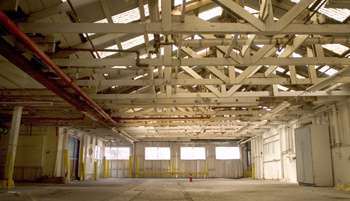
Photographs by Stephen Laufer
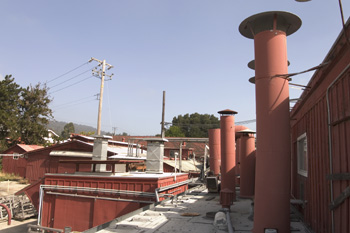
Skyscape: The folks behind the Tannery Arts Center hope to preserve these cute red chimney pots.
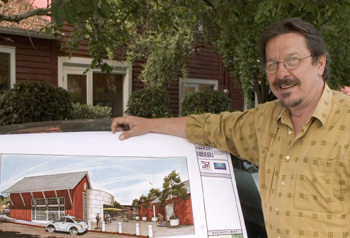
Bug Me Out: Project director George Newell looks into the future outside some of the original tannery buildings.
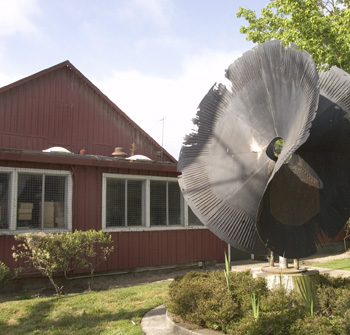
Resurfacing: Former tannery equipment takes on a new life as sculpture outside the tannery.
For further information, the FEIR is available at the City Redevelopment Agency or its website, www.ci.santa-cruz.ca.us/ra.
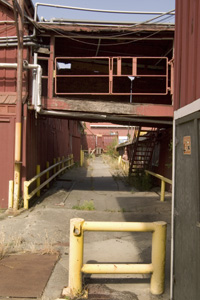
Yellow Pipe Road: Everything looks artsy over at the former Salz Tannery site.
From the June 8-15, 2005 issue of Metro Santa Cruz.